History

 Martiens Louw and Robbie Barnard, hooker and prop, who played together for Transvaal and South Africa, have died just over a week apart.
Martiens Louw and Robbie Barnard, hooker and prop, who played together for Transvaal and South Africa, have died just over a week apart.
Louw died in Pretoria on 12 October 2013 and Barnard on 20 October 2013. Louw was 75, Barnard 71.
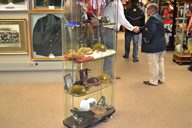 I am virtually speechless, gobb-smacked… I actually touched rugby history today!
I am virtually speechless, gobb-smacked… I actually touched rugby history today!
Rugby-Talk was invited to the grand opening of the Ellis Park Rugby Museum, which happened this morning.
The museum boasts probably the biggest single collection of rugby memorabilia in South Africa and probably the entire world, with memorabilia from the earliest days of rugby, rugby in South Africa both Provincially and on a Franchise level and of course probably the biggest element being the fantastic Springbok collection.
There are International jerseys, blasers, signed balls, penadants, artworks as well as other visual elements from all over, it is mind-boggling and to do justice to the exhibition one actually needs several hours to see everything properly, let alone study every ehibit.
The collection is owned by Swys Joubert, who played Provincial rugby in SA, and also played rugby in the UK and France.
Firstly, well done Swys, what an awesome experience!
 Springboks and former national team captains were united in predicting that the new Springbok Experience rugby museum would be a major success after it opened its doors to the public at the V&A Waterfront in Cape Town for the first time on Tuesday.
Springboks and former national team captains were united in predicting that the new Springbok Experience rugby museum would be a major success after it opened its doors to the public at the V&A Waterfront in Cape Town for the first time on Tuesday.
Springbok captain Jean de Villiers was the first official visitor to the new attraction closely followed by the rest of the Springbok squad and former national team captains, all of whom were ‘wowed’ by the world-class new installation – before the doors were thrown open to the public at the sounding of the noon gun.
 Australians are today mourning the death of a legend.
Australians are today mourning the death of a legend.
Edward Heinrich, who is considered a classic Wallaby, has passed away last night at the age of 73.
 Mr Oregan Hoskins, President of the South African Rugby Union (SARU), on Sunday paid tribute to former SARU vice-president and long-serving rugby administrator, Koos Basson, who passed away on Saturday. He was 74.
Mr Oregan Hoskins, President of the South African Rugby Union (SARU), on Sunday paid tribute to former SARU vice-president and long-serving rugby administrator, Koos Basson, who passed away on Saturday. He was 74.
Mr Basson had recently become ill with a heart condition and had been discharged from hospital on Monday.
He passed away at home during the Springboks’ match against New Zealand, doing the thing that he most enjoyed in life, watching rugby, said his widow, Stella.
Some Great pictures of big moments in South African Rugby
 Tappe Henning seems to be on his way to Edinbrugh to take over Scottish refereeing.
Tappe Henning seems to be on his way to Edinbrugh to take over Scottish refereeing.
A three year contract was signed on Monday, for Henning to become the Scottish Referee Commissioner.
 The Blue Bulls Rugby Union and Blue Bulls Company are saddened by the news that Professor Fritz Eloff passed away on Thursday, September 5th, 2013. The BBRU and BBC extend condolences to his family and wish them strength during this difficult time.
The Blue Bulls Rugby Union and Blue Bulls Company are saddened by the news that Professor Fritz Eloff passed away on Thursday, September 5th, 2013. The BBRU and BBC extend condolences to his family and wish them strength during this difficult time.
He leaves behind two daughters and two grandchildren.
 Former Wales and British and Irish Lions flyhalf Cliff Morgan has died at the age of 83, the Welsh Rugby Union announced on Thursday.
Former Wales and British and Irish Lions flyhalf Cliff Morgan has died at the age of 83, the Welsh Rugby Union announced on Thursday.
 South Africa 17 / 6 Bay of plenty-Thames Valley-Counties
South Africa 17 / 6 Bay of plenty-Thames Valley-Counties
It was the last midweek match of the tour with only the 4th test remaining. The opposition was a combination of 3 relatively weak sides namely Bay of Plenty (who won only 1 of 5 matches played in the 1956 season); Thames Valley (who won only 3 of 8) and Counties (a team founded as South Auckland in 1926 and who won only 2 of 13 season games in 1956). These three teams combined for the first time in 1956 and played 2 warm-up games namely against Auckland (7th of August 1956 losing 6-7) and Waikato (11th of August 1956 losing 6-24) in preparation for the Springboks.
 Wales lock Alun Wyn Jones will captain the Lions in the final Test against Australia on Saturday after Brian O’Driscoll was dropped from the squad. Irishman O’Driscoll was favourite to replace injured skipper Sam Warburton.
Wales lock Alun Wyn Jones will captain the Lions in the final Test against Australia on Saturday after Brian O’Driscoll was dropped from the squad. Irishman O’Driscoll was favourite to replace injured skipper Sam Warburton.
 It was the Springboks’ best performance of the tour. A real confidence booster after the shock defeat against the University side but at the same time a game that had a negative impact in more than one way. It showed New Zealand the danger of allowing the Springboks space to play the Craven-linking pattern. Not that New Zealand was unaware of the Springbok style but it re-affirmed the necessity of keeping the Springboks on the back foot.
It was the Springboks’ best performance of the tour. A real confidence booster after the shock defeat against the University side but at the same time a game that had a negative impact in more than one way. It showed New Zealand the danger of allowing the Springboks space to play the Craven-linking pattern. Not that New Zealand was unaware of the Springbok style but it re-affirmed the necessity of keeping the Springboks on the back foot.
 Munster have announced that current squad captain Doug Howlett will retire from professional rugby at the end of this season.
Munster have announced that current squad captain Doug Howlett will retire from professional rugby at the end of this season.
 The Western Province Rugby Football Union (WPRFU) have announced that will be raising funds for former player, Tinus Linee at next week’s Super Rugby match between the Stormers and the Reds at Newlands.
The Western Province Rugby Football Union (WPRFU) have announced that will be raising funds for former player, Tinus Linee at next week’s Super Rugby match between the Stormers and the Reds at Newlands.
 Today we received an open letter to Jurie Roux, SARU CEO, lamenting the fact that the design and production of the nationally important new Springbok Museum in Cape Town was awarded to a UK (English) design company.
Today we received an open letter to Jurie Roux, SARU CEO, lamenting the fact that the design and production of the nationally important new Springbok Museum in Cape Town was awarded to a UK (English) design company.
A number of years ago I learnt and realised first hand how apathetic South Africans are when it comes to doing something for this sport we love so much, rugby in South Africa. I learnt that SARU can do anything they want, there will be a few muted murmers and a lot of around the braai chatter about how these fools run OUR game, but nobody does anything about it and eventually these fools at SARU just laugh at us… seeing us all as mere consumers of the game, not de facto stakeholders in the game.
Suffice to say that I am deeply concerned about how SARU runs rugby in South Africa and for South African interests.
Without further a do, here is the exact contents of the letter, take a look for yourself:
 Former Springbok Tinus Linee has been diagnosed with the same disease suffered by former Springbok Joost van der Westhuizen, it was reported on Tuesday.
Former Springbok Tinus Linee has been diagnosed with the same disease suffered by former Springbok Joost van der Westhuizen, it was reported on Tuesday.
 Noticeably, conversation about the 1956 tour always detour to the match against the New Zealand Universities. Historically, it was the first time a New Zealand University team played against an international touring side but this match is synonymous with the 1956 tour for other reasons. The fact that the Universities team won is also not really the main reason why Kiwi’s still rate this match as the best match of the tour. It was the manner in which the Universities team won that delighted the New Zealand rugby fraternity. All the good football came from the home side. The backs demonstrated opportunism, sensible anticipation and application while the pack totally dominated proceedings. The game is nevertheless mostly remembered as the game of the great Ron Jardon ‘try-that-wasn’t’. A great howl went up in protest when Jardon was called back after a spectacular 65 meter run through almost the entire Springbok team (listen to Winston McCarthy highlights of the match here) and old-timers almost without exception still mention the Jardon try to this day whenever the 1956 tour are under discussion.
Noticeably, conversation about the 1956 tour always detour to the match against the New Zealand Universities. Historically, it was the first time a New Zealand University team played against an international touring side but this match is synonymous with the 1956 tour for other reasons. The fact that the Universities team won is also not really the main reason why Kiwi’s still rate this match as the best match of the tour. It was the manner in which the Universities team won that delighted the New Zealand rugby fraternity. All the good football came from the home side. The backs demonstrated opportunism, sensible anticipation and application while the pack totally dominated proceedings. The game is nevertheless mostly remembered as the game of the great Ron Jardon ‘try-that-wasn’t’. A great howl went up in protest when Jardon was called back after a spectacular 65 meter run through almost the entire Springbok team (listen to Winston McCarthy highlights of the match here) and old-timers almost without exception still mention the Jardon try to this day whenever the 1956 tour are under discussion.
 After the trails for the selection of a Springbok side to tour the United Kingdom in 1931 the general feeling among selectors was that another equally strong Springboks side could easily be selected. That is a second Springbok team of almost equal ability that could potentially challenge if not beat the side that was selected to tour.
After the trails for the selection of a Springbok side to tour the United Kingdom in 1931 the general feeling among selectors was that another equally strong Springboks side could easily be selected. That is a second Springbok team of almost equal ability that could potentially challenge if not beat the side that was selected to tour.
A tour was consequently arranged for these unlucky players to Argentina and the team was officially called the Gazelle. This tour took place in 1932 under the management of Paul Roos and the captaincy of Joe Nykamp. The side consisting of uncapped players wore blue shirts emblazoned with springbok head, red stockings and white shorts. They played eight matches; won all of them and scored 269 points with only 24 points scored against them. The two matches against a representative Argentinian side the Gazelles won 42-0 and 34-3 respectively. Gimnasia y Esgrima, a club coached and captained by B.H Heatlie gave the South African Gazelles stern opposition and lost by only 11-5 in the last game of the tour. Heatlie was the man who captained South Africa in their first ever international against a British touring side.
 Current captain Jean de Villiers will join the oldest living Springbok skipper, 83-year-old Des van Jaarsveldt, and 40 others in Cape Town on Wednesday, to mark the countdown to the opening of a new rugby museum.
Current captain Jean de Villiers will join the oldest living Springbok skipper, 83-year-old Des van Jaarsveldt, and 40 others in Cape Town on Wednesday, to mark the countdown to the opening of a new rugby museum.
 We take a look at Springbok participation in the Tri-Nations (now expanded and renamed The Rugby Championship).
We take a look at Springbok participation in the Tri-Nations (now expanded and renamed The Rugby Championship).
The Springboks took part in the Southern Hemisphere’s premier international competition just five years after being readmitted to international competition in the 90’s.
 Here we are midweek already and looking forward to the coming weekend’s rugby. Most of the attention up north is due to be focussed on the RaboDirect Pro12 and the Aviva Premiership as there is yet another break in the RBS 6 Nations tournament. Last weekend’s rugby may now be a distant memory but felt it would be interesting to share the views of two former international players of the action between Scotland and Ireland.
Here we are midweek already and looking forward to the coming weekend’s rugby. Most of the attention up north is due to be focussed on the RaboDirect Pro12 and the Aviva Premiership as there is yet another break in the RBS 6 Nations tournament. Last weekend’s rugby may now be a distant memory but felt it would be interesting to share the views of two former international players of the action between Scotland and Ireland.
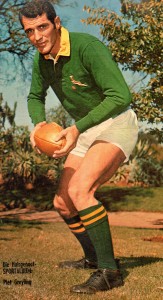
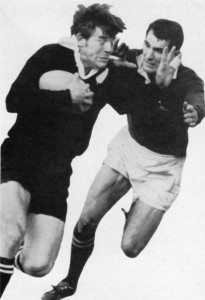 After my tribute to Jan Ellis I thought I just have to write something about the man who was a big part of Jan’s success as a Springbok rugby player, Piet Greyling.
After my tribute to Jan Ellis I thought I just have to write something about the man who was a big part of Jan’s success as a Springbok rugby player, Piet Greyling.
Currie Cup-winning Transvaal captain in 1971 and 1972, former Springbok flanker Piet Greyling, was arguably one of the best, but certainly one of the toughest.
The picture below shows Piet Greyling with his Transvaal side who got a share of the Currie Cup for the first time in 19 years – having previously won it in 1952 – when they shared the cup with Northern Transvaal in an epic final and controversial 14-14 draw at Ellis Park in 1971. The next year Greyling led his Transvaal side to a 25-19 win over Eastern Transvaal at Pam Brink Stadium in Springs to win the cup with the help of Gerald Bosch who dropped the winning points in the final minutes. It was back in 1972, before the Currie Cup final against Eastern Transvaal in Springs that the former Bok captain uttered these famous words to his Transvaal team-mates: “Eighty minutes of agony for an eternity of pleasure.”
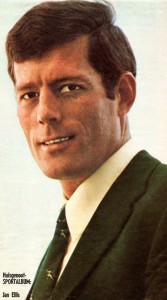 With the news this week that Springbok great, Jan Ellis, passed away at the age of 71, I just had to write this tribute to Jan.
With the news this week that Springbok great, Jan Ellis, passed away at the age of 71, I just had to write this tribute to Jan.
Jan Ellis personifies Springbok rugby for me. It has been said that as humans we think in pictures. When we think of something we see a picture of some sorts and this picture can differ from one person to the next, which is why we sometimes voice the same words but come up with different understanding or meaning. The best communicators are those who can create clear and vivid pictures in the mind of his listeners.
When I think of Springbok rugby I see Jan Ellis. Hard, uncompromising, fast with a touch of artistic moodiness and flair but with relentless motivation to succeed based on a staunch work ethic and absolute conviction of what is right and wrong – that is Jan Ellis in a nutshell, for me.
So, I don’t see all that, I just see pictures of Jan Ellis flashing through my mind.
(see the photo gallery I’ve created of Jan Ellis here).
The analogy between the Springboks and Jan Ellis, for me, came along probably because I had so many pictures of Jan Ellis when I started with my sampling of rugby pictures in 1970. I was born in Windhoek, South West Africa (now Namibia) and Jan was SWA’s second Springbok, the first being Sias Swart.
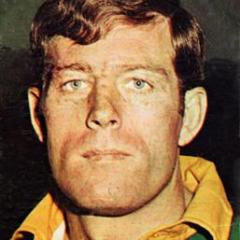 The South African Rugby Union on Friday expressed its deep sadness at the passing of legendary former Springbok looseforward, Jan Ellis.
The South African Rugby Union on Friday expressed its deep sadness at the passing of legendary former Springbok looseforward, Jan Ellis.
The one-time joint record holder for the number of Springbok caps succumbed to cancer at a hospice in Pretoria after suffering from the disease for some time. He celebrated his 71st birthday in January.
 The 1974 Tour of the Lions to South Africa was undoubtedly the most unsettling tour ever for Springbok rugby. Touring unbeaten through South Africa superior in every aspect in virtually every single match including the test matches it was a massive wake-up call for South African rugby.
The 1974 Tour of the Lions to South Africa was undoubtedly the most unsettling tour ever for Springbok rugby. Touring unbeaten through South Africa superior in every aspect in virtually every single match including the test matches it was a massive wake-up call for South African rugby.
I was 12 years old when this tour eventuated. In my mind at that time the Springboks had an aura of invincibility. I was too young to know about the 1956 and 1965 tours as the patriotic Afrikaans media did not write much about it. The country was still in euphoria after the 1970 victory over Lochore’s All Blacks and the unbeaten 1971 tour to Australia. It was never said in so many words but generally the 1972 loss against England was seen as just a hiccup; a fleeting glitch due to team selections and underestimation of the opposition.
 Doctor Louis Luyt, a big man and bigger figure in Rugby Circles in South African Rugby, passed away ealier today, 1 February 2013.
Doctor Louis Luyt, a big man and bigger figure in Rugby Circles in South African Rugby, passed away ealier today, 1 February 2013.
 As reported earlier, the gravely sick former WP and Stormers prop, has died of cancer.
As reported earlier, the gravely sick former WP and Stormers prop, has died of cancer.
 First match: 15 May 1956 – Canberra
First match: 15 May 1956 – Canberra
South Africa 41 / Australian Capital Territory (ACT) 6
Promoting rugby union was paramount in Australia when the Springboks arrived in 1956. Consequently -soon after arrival- at a civic reception at the Sydney Town Hall Danie Craven and Basie Viviers promised to play open attractive rugby to help rugby union in their battle for player volume against rugby league.
The team travelled to Canberra for the first match against an Australian Capital Territory team. This match was not part of the original tour itinerary and was arranged as a tribute to the resolute efforts of local administrators to gain footing for union rugby in an area with a population basis slightly bigger than Paarl in Cape Province, South Africa.
 Former Australia coach Bob Dwyer was recovering in hospital Thursday after suffering a heart attack, the Australian Rugby Union said.
Former Australia coach Bob Dwyer was recovering in hospital Thursday after suffering a heart attack, the Australian Rugby Union said.
 Morne van der Merwe, ex WP and Stormers prop, has only days to live.
Morne van der Merwe, ex WP and Stormers prop, has only days to live.
He was diagnosed with a brain tumor two years ago and his wife, Cindy, is hurriedly putting together mementoes of his life to keep for the couple.s two young boys.
 The Blue Bulls Rugby Union is very pleased to honour Lourens (LM) Smit, who celebrated his 100th birthday on Monday.
The Blue Bulls Rugby Union is very pleased to honour Lourens (LM) Smit, who celebrated his 100th birthday on Monday.
Smit is the oldest living player that has represented the union and played in their very first match ever, in 1938.
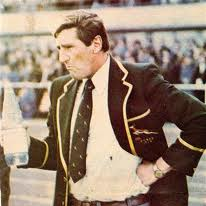 Ian Kirkpatrick, great rugby man, died suddenly at his home in Helderberg Village on Sunday. He was 82. His influence on South African rugby over six decades cannot be overestimated.
Ian Kirkpatrick, great rugby man, died suddenly at his home in Helderberg Village on Sunday. He was 82. His influence on South African rugby over six decades cannot be overestimated.
On Friday he complained of a ‘stomach upset’ and cancelled a meeting with an overseas company about to make a documentary on the 1974 tour, when Kirkpatrick was a national selector.
His playing career was great. He left Kimberley Boys’ high and at the age of 19 and played for Griquas. The next year he went to the Springbok trials at Newlands when the great Springbok team was chosen for the 1951-52 tour. In 1953 he made his Springbok debut against the Wallabies at Newlands, playing flyhalf.
Kirkie played for South Africa in 13 Tests. Of the 13 two were lost, and on each occasion it was at Newlands (against Australia and France) and he was at flyhalf. In 10 Tests he was at centre in partnership with John Gainsford.
 ‘n Rugbylegende is volksbesit; iemand wat ver buite die grense van provinsialisme aanvaar en bewonder word. Noord-Transvaal en die Blou Bulle het van die wêreld se grootste rugbylegendes opgelewer.
‘n Rugbylegende is volksbesit; iemand wat ver buite die grense van provinsialisme aanvaar en bewonder word. Noord-Transvaal en die Blou Bulle het van die wêreld se grootste rugbylegendes opgelewer.
Third Test – Lancaster Park, Christchurch, 18 August 1956
New Zealand 17 / South Africa 10
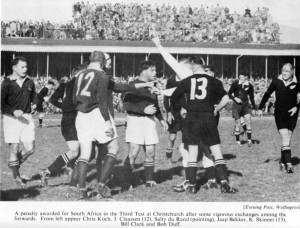 Skinner: “From what I’ve read over the years you’d have thought the fighting in that third test lasted the entire game, but that simply wasn’t true. There were only two punches – one that floored Koch and the one that stopped Bekker.”
Skinner: “From what I’ve read over the years you’d have thought the fighting in that third test lasted the entire game, but that simply wasn’t true. There were only two punches – one that floored Koch and the one that stopped Bekker.”
Don Clarke: “Kevin Skinner is quite a modest man but I saw his knuckles after the match.”
 Media reports are quick to plug that the Springboks have never lost to the Pumas.
Media reports are quick to plug that the Springboks have never lost to the Pumas.
However I can still remember the day in 1982 when Hugo Porta’s South American team, the Jaguars, gave the Springboks a hiding 21-12 with Porta scoring all his team’s points by running in a try, kicking a drop goal, and slotting a few penalties and a conversion.